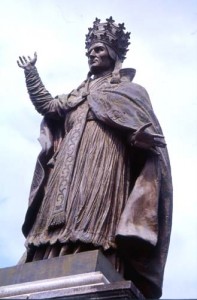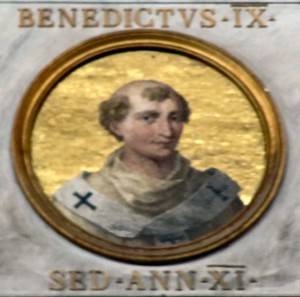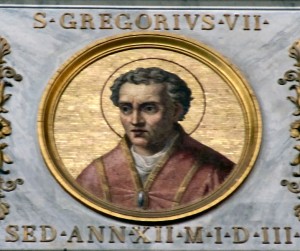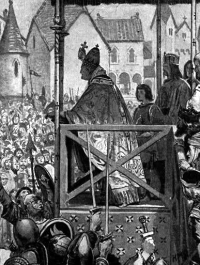The eleventh century deserves more attention. Continue reading →
Every century has produced astounding popes. If I were forced to pick one century on which to concentrate, however, it would definitely be the eleventh.

The statue of Gerbert in Aurillac
The first pope in the eleventh century was Gerbert of Aurillac. Widely known as one of the smartest men in all of Europe, he was hand-picked by the nineteen-year-old Holy Roman Emperor Otto III to become Supreme Pontiff in 999. He took the name Sylvester II because he hoped to emulate the very close relationship that was reportedly enjoyed by the first Christian emperor, Constantine, and the pope at the time, Sylvester I.
Pope Sylvester II was not particularly popular among the Romans. Three factors were working against him:
- He was a foreigner. He lived in France and studied in Spain with the Saracens.
- He was chosen by the emperor, not the Romans.
- He was so clever that he was widely suspected of employing witchcraft.
Otto died under mysterious circumstances in Italy in 2002. The pope only outlasted him by a year. Some people attribute their untimely demises to the work of the Crescentius family, which installed the next three popes: John XVII, John XVIII, and Sergius IV, also known as Peter Pig-snout. All told, they held the papacy for about nine years.
What transpired next is unclear, but somehow Count Gregory of Tusculum, which sat atop the northernmost of the Alban Hills, about fifteen miles south of Rome, supplanted the Crescentius family, to which he was related, as the chief power-broker in Rome. Count Gregory arranged for his son to become Pope Benedict VIII, and Benedict was succeeded by his brother, Pope John XIX. Although both of these pontificates were relatively tranquil and successful, the fact that the two popes received their appointments from their father has been held against them. Nevertheless, it is undeniable that Pope Benedict was instrumental in the expulsion of the Saracens from Italy and that conditions on the peninsula improved markedly during the twenty-year span of the fraternal pontificates.

The mosaic of Pope Benedict IX in St. Paul’s Outside the Walls
The next pope, who also hailed from Tusculum, was my all-time favorite, Benedict IX. His father was the brother of the two previous pontiffs, and he made sure that his young son got to sit on the Throne of Peter. How young? Well, one chronicler claimed that he was only ten years old, but this is probably a mistake. The best guess is that he was about twice that.
If you look on any list of the popes, you may be surprised to see Pope Benedict IX on it three times. Once he sold the papacy to his godfather, John Gratian, so that he could get married and once he was removed from the papacy by the Holy Roman Emperor. Both times he came back and resumed his pontificate, and the Church has always considered both Benedict and the men who served in his absence as legitimate popes. The last pontificate did not last long. He was expelled in 1048 for the last time by Emperor Henry III.
What happened to Pope Benedict after he was overthrown the last time is disputed. He was still a young man, certainly less than forty years of age. For centuries the monastery at Grottaferrata, which was donated by Benedict’s grandfather, had a plaque that indicated that the former pontiff had died there decades later. Unfortunately the plaque was destroyed in World War II.

The mosaic of Pope Gregory VII
The emperor controlled the papacy for the next twenty-five years. However, during this time a Tuscan monk named Hildebrand was slowly but surely consolidating his power, and in 1073 he became Pope Gregory VII. His dispute with Emperor Henry IV, who went so far as to install an anti-pope, is extremely famous. The pope excommunicated the emperor, then forgave him, and then waged political and actual war with him for years. The pope invited the Norman count, Robert Guiscard, to help him ward off the emperor. The assistance was granted, but after the battle the Norman troops sacked Rome. The Romans blamed the pope for this debacle, and he spent the last years of his pontificate in exile, but not before designating monks as his two successors.

Pope Urban II launched the First Crusade at Clermont
Pope Urban II closed out the century by somehow persuading a good portion of the fighting men of Europe to make the arduous trip to the Middle East to wrest control of Jerusalem from the Muslims. Many thousands died in the effort, but Jerusalem was indeed captured by the soldiers of the First Crusade in July of 1099, just before the death of the pontiff.
Many other interesting events transpired in the eleventh century — the spread of the monasteries, the cults of the saints, the widespread theft of relics, the Great Schism, the Norman conquests, and the reform movement to name a few. Each might make a suitable subject for a post.
The problem is that the contemporaneous accounts that have survived from the period are notoriously unreliable. Many have been shown to be replete with exaggerations and outright lies. Furthermore, most of the population in the eleventh century was illiterate. The only people who were both capable of writing and had access to parchment (paper was not yet in production in Europe) and writing materials were monks and high-level nobles and clergy. Their writings generally reflected their biases.






